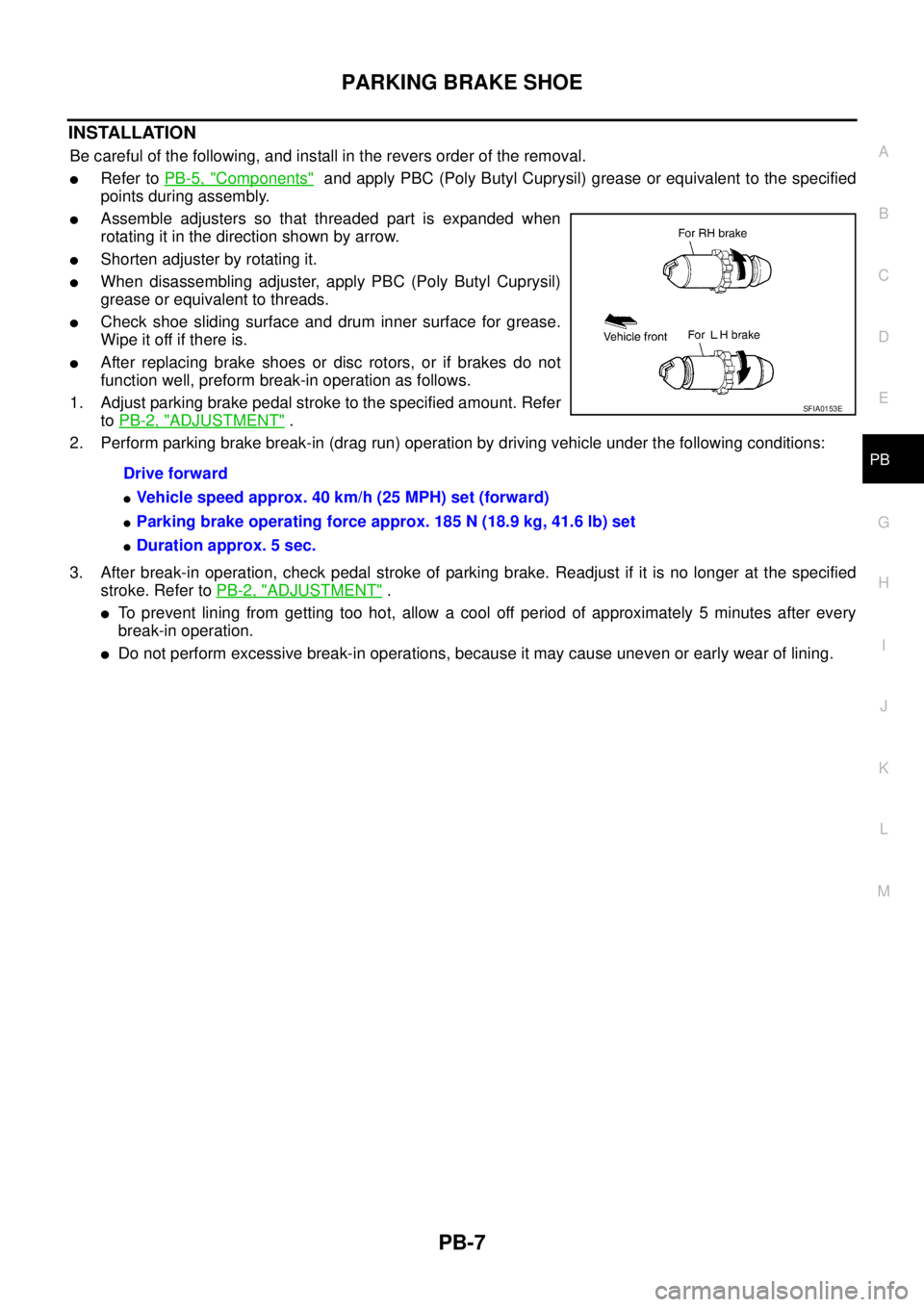Page 925 of 3502
![NISSAN TEANA 2003 Service Manual TROUBLE DIAGNOSIS
BRC-65
[VDC/TCS/ABS]
C
D
E
G
H
I
J
K
L
MA
B
BRC
For Fast and Accurate DiagnosisBFS000E6
PRECAUTIONS FOR DIAGNOSIS
�Be sure to check the procedures of “How to Perform Trouble Diag NISSAN TEANA 2003 Service Manual TROUBLE DIAGNOSIS
BRC-65
[VDC/TCS/ABS]
C
D
E
G
H
I
J
K
L
MA
B
BRC
For Fast and Accurate DiagnosisBFS000E6
PRECAUTIONS FOR DIAGNOSIS
�Be sure to check the procedures of “How to Perform Trouble Diag](/manual-img/5/57392/w960_57392-924.png)
TROUBLE DIAGNOSIS
BRC-65
[VDC/TCS/ABS]
C
D
E
G
H
I
J
K
L
MA
B
BRC
For Fast and Accurate DiagnosisBFS000E6
PRECAUTIONS FOR DIAGNOSIS
�Be sure to check the procedures of “How to Perform Trouble Diagnosis” in advance. Refer to GI-4, "Gen-
eral Precautions" .
�Always adjust the neutral position of steering angle sensor before driving when removing and installing
ABS actuator and electric unit (control unit), steering angle sensor, suspension parts and adjusting align-
ment. Refer to BRC-40, "
Adjustment of Steering Angle Sensor Neutral Position" .
�Always erase memory after completing trouble diagnosis. Refer to BRC-58, "ERASE MEMORY" .
�When inspection of the continuity or voltage between modules or units is performed, check connector ter-
minals for disconnection, looseness, bend, or collapse. Repair or replace applicable part if any non-stan-
dard condition is detected.
�Intermittent malfunctions may be caused by a poor connection in the harness, connectors, and terminals.
Move harnesses, harness connectors, and terminals by hand to make sure all connections are solid and
undamaged.
�Do not to forcibly extend any connector terminal if a circuit tester is used for the check.
�The symptom shown in the table may occur, but the system is operating normally.
Symptom Symptom description Result
Motor operation soundThis is the operation sound of the motor in the actuator and electric unit.Slight
sound may occur during VDC, TCS and ABS operation.
Normal
Just after the engine starts, the motor operating noise may be heard. This is a
normal status of the system operation check.
System operation check soundWhen engine starts, “click” sound may be heard from engine room. This is nor-
mal status of system operation check.Normal
VDC/TCS operation
(SLIP indicator lamp ON)TCS may activate momentarily if wheel speed changes when driving over
location where friction coefficient varies, when downshifting, or when fully
depressing accelerator pedal.
Normal
Cancel the VDC/
TCS function for
the inspection on
a chassis dyna-
mometer. Before the speed meter inspection, push VDC OFF switch to cancel the VDC/
TCS function.
When accelerator pedal is depressed on a chassis dynamometer (front wheel
fixing type), the vehicle speed will not increase. This is normal. It is result of
TCS being activated by stationary front wheels. The warning lamp may also
turn on to show “sensor system malfunction” in this case. This is also normal,
and is the result of the stationary front wheels being detected. Restart engine,
and drive the vehicle at 30 km/h (19 MPH) or more to make sure that the warn-
ing lamp no longer turns on.
ABS operation
(Longer stopping distance)When driving on roads with a low coefficient of friction, such as snowy roads or
gravel roads, the stopping distance is sometimes longer for vehicles equipped
with ABS. Therefore, when driving on such roads, drive at a sufficiently
reduced speed to be safe.Normal
Sluggish feelDepending on road conditions, the driver may have a sluggish feel. This is
because traction control, which controls engine and brakes to achieve optimal
traction, has the highest priority (for safety). As a result sometimes the driver
has a less slight sluggish feel in response than usual acceleration feel.Normal
Page 959 of 3502
OVERHEATING CAUSE ANALYSIS
CO-7
[QR]
C
D
E
F
G
H
I
J
K
L
MA
CO
Except cool-
ing system
parts mal-
function— Overload on engineAbusive drivingHigh engine rpm under no
load
Driving in low gear for
extended time
Driving at extremely high
speed
Power train system mal-
function
— Installed improper size
wheels and tires
Dragging brakes
Improper ignition timing
Blocked or restricted air
flowBlocked bumper —
— Blocked radiator grilleInstalled car brassiere
Mud contamination or
paper clogging
Blocked radiator —
Blocked condenser
Blocked air flow
Installed large fog lamp Symptom Check items
Page 983 of 3502
OVERHEATING CAUSE ANALYSIS
CO-31
[VQ]
C
D
E
F
G
H
I
J
K
L
MA
CO
Except cool-
ing system
parts mal-
function— Overload on engineAbusive drivingHigh engine rpm under no
load
Driving in low gear for
extended time
Driving at extremely high
speed
Powertrain system mal-
function
— Installed improper size
wheels and tires
Dragging brakes
Improper ignition timing
Blocked or restricted air
flowBlocked bumper —
— Blocked radiator grilleInstalled car brassiere
Mud contamination or
paper clogging
Blocked radiator —
Blocked condenser
Blocked air flow
Installed large fog lamp Symptom Check items
Page 2386 of 3502
FAX-4
NOISE, VIBRATION AND HARSHNESS (NVH) TROUBLESHOOTING
NOISE, VIBRATION AND HARSHNESS (NVH) TROUBLESHOOTINGPFP:00003
NVH Troubleshooting ChartBDS0007J
Use chart below to help you find the cause of the symptom. If necessary, repair or replace these parts.
×: ApplicableReference page
—
FAX-16
FA X -2 0
FAX-24
FAX-30
—
FAX-5—
FAX-5
NVH in FAX and FSU sections
Refer to Front axle in this chart.
NVH in WT section
NVH in WT section
Refer to DRIVE SHAFT in this chart.
NVH in BR section
NVH in PS section
Possible cause and Suspected parts
Excessive joint angle
Joint sliding resistance
Imbalance
Improper installation, looseness
Parts interference
Wheel bearing damage
FRONT AXLE AND FRONT SUSPENSION
FRONT AXLE
TIRES
ROAD WHEELS
DRIVE SHAFT
BRAKES
STEERING
SymptomDRIVE
SHAFTNoise×× ××××× ××
Shake× × ××××× ××
FRONT
AXLENoise×××× ×××××
Shake×××× ×××××
Vibration×××× × × ×
Shimmy×××××××
Judder× × ×× ××
Poor quality ride or handling×××××
Page 2432 of 3502
FSU-4
NOISE, VIBRATION AND HARSHNESS (NVH) TROUBLESHOOTING
NOISE, VIBRATION AND HARSHNESS (NVH) TROUBLESHOOTINGPFP:00003
NVH Troubleshooting ChartBES0003J
Use chart below to help you find the cause of the symptom. If necessary, repair or replace these parts.
×: ApplicableReference page
FSU-7FSU-12
—
—
—
FSU-7FSU-5FSU-16
NVH in FAX and FSU section
NVH in WT section
NVH in FAX section
NVH in BR section
NVH in PS section
Possible cause and Suspected parts
Improper installation, looseness
Strut deformation, damage or deflection
Bushing or mounting deterioration
Parts interference
Spring fatigue
Suspension looseness
Incorrect wheel alignment
Stabilizer bar fatigue
FRONT AXLE AND FRONT SUSPENSION
ROAD WHEELS
DRIVE SHAFT
BRAKES
STEERING
Symptom Front suspensionNoise×××××× ×××××
Shake×××× × ×××××
Vibration××××× × × ×
Shimmy×××× ×××××
Judder××× ×× × ×
Poor quality ride or handling××××× ××××
Page 3027 of 3502

PB-1
PARKING BRAKE SYSTEM
F BRAKES
CONTENTS
C
D
E
G
H
I
J
K
L
M
SECTION PB
A
B
PB
PARKING BRAKE SYSTEM
PARKING BRAKE SYSTEM ...................................... 2
On-Vehicle Inspection .............................................. 2
PEDAL STROKE ................................................... 2
INSPECT COMPONENTS .................................... 2
ADJUSTMENT ...................................................... 2
PARKING BRAKE CONTROL ................................... 3
Components ............................................................. 3
Removal and Installation .......................................... 3
REMOVAL ............................................................. 3
INSTALLATION ..................................................... 4PARKING BRAKE SHOE ........................................... 5
Components ............................................................. 5
Removal and Installation .......................................... 5
REMOVE ............................................................... 5
INSPECTION AFTER REMOVAL ......................... 6
INSTALLATION ..................................................... 7
SERVICE DATA AND SPECIFICATIONS (SDS) ........ 8
Parking Drum Brake ................................................. 8
Parking Brake Control .............................................. 8
Page 3033 of 3502

PARKING BRAKE SHOE
PB-7
C
D
E
G
H
I
J
K
L
MA
B
PB
INSTALLATION
Be careful of the following, and install in the revers order of the removal.
�Refer to PB-5, "Components" and apply PBC (Poly Butyl Cuprysil) grease or equivalent to the specified
points during assembly.
�Assemble adjusters so that threaded part is expanded when
rotating it in the direction shown by arrow.
�Shorten adjuster by rotating it.
�When disassembling adjuster, apply PBC (Poly Butyl Cuprysil)
grease or equivalent to threads.
�Check shoe sliding surface and drum inner surface for grease.
Wipe it off if there is.
�After replacing brake shoes or disc rotors, or if brakes do not
function well, preform break-in operation as follows.
1. Adjust parking brake pedal stroke to the specified amount. Refer
to PB-2, "
ADJUSTMENT" .
2. Perform parking brake break-in (drag run) operation by driving vehicle under the following conditions:
3. After break-in operation, check pedal stroke of parking brake. Readjust if it is no longer at the specified
stroke. Refer to PB-2, "
ADJUSTMENT" .
�To prevent lining from getting too hot, allow a cool off period of approximately 5 minutes after every
break-in operation.
�Do not perform excessive break-in operations, because it may cause uneven or early wear of lining.Drive forward
�Vehicle speed approx. 40 km/h (25 MPH) set (forward)
�Parking brake operating force approx. 185 N (18.9 kg, 41.6 lb) set
�Duration approx. 5 sec.
SFIA0153E
Page 3120 of 3502

PS-6
NOISE, VIBRATION AND HARSHNESS (NVH) TROUBLESHOOTING
NOISE, VIBRATION AND HARSHNESS (NVH) TROUBLESHOOTINGPFP:00003
NVH Troubleshooting ChartBGS0003O
Use chart below to help you find the cause of the symptom. If necessary, repair or replace these parts.
×: ApplicableReference page
PS-7PS-7PS-23PS-23PS-23PS-7PS-9PS-9
EM-14
, EM-128PS-9PS-15PS-23PS-13PS-12PS-20
NVH in FAX, RAX, FSU, RSU section
NVH in WT section
NVH in WT section
NVH in FAX section
NVH in BR section
Possible cause and SUSPECTED PARTS
Fluid level
Air in hydraulic system
Outer socket ball joint swing torque
Outer socket ball joint rotating torque
Outer socket ball joint end play
Steering fluid leakage
Steering wheel play
Steering gear rack sliding force
Drive belt looseness
Improper steering wheel
Improper installation or looseness or tilt lock lever
Mounting rubber deterioration
Steering column deformation or damage
Improper installation or looseness of steering column
Steering linkage looseness
AXLE and SUSPENSION
TYRES
ROAD WHEEL
DRIVE SHAFT
BRAKES
Symptom SteeringNoise× × ××××× × × ×××× ×
Shake××× ×××× ×
Vibration××××× ×× ×
Shimmy××× × ××× ×
Judder× × ××× ×